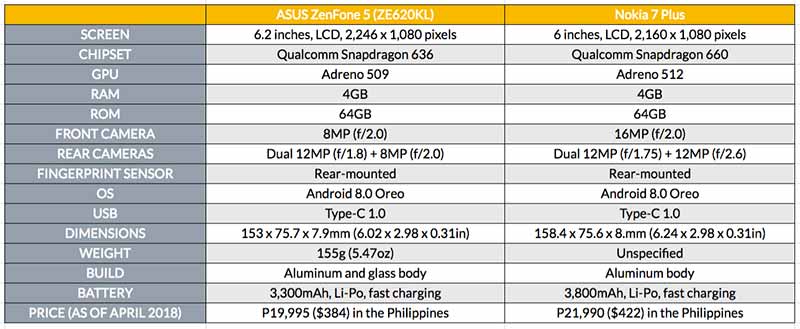Now that ASUS has made the ZenFone 5 official in the Philippines, it’s time to figure out how it stacks up against the Nokia 7 Plus, which also recently debuted locally.
Both midrange phones are reasonably priced, with the ASUS ZenFone 5 being the cheaper of the two, officially coming in at P19,995 (around $385). Preorders for the P21,990 ($423) Nokia 7 Plus began last week, and it’ll be available from April 27.
The case for the ASUS ZenFone 5
Besides a more palatable price tag, the latest hero device from ASUS gets a fancier outward appearance, having a glossy finish all around and a notch above the screen a la the Apple iPhone X. As a consequence of that finish, though, the ZenFone 5 is harder to keep looking clean as it ages.
In terms of handling, the ASUS phone’s smaller dimensions could mean an easier time using it for long periods, even if only a wee bit. At 6.2 inches, its screen is slightly larger, too; the wider aspect ratio, more suited for viewing content and playing games in landscape mode.
However, note that full notch support will only arrive once Android P (Popsicle?) is released and developers update their apps accordingly to make best use of the ASUS ZenFone 5’s irregular picture format.
The case of the Nokia 7 Plus
HMD Global’s premium mid-tier offering has a lot going for it, actually. And you don’t need to spend a small fortune for its feature set.
And while not quite the looker the ASUS ZenFone 5 is, the Nokia 7 Plus is built from a slab of solid aluminum with copper accents for added visual flair. Around the back, you’ll find two cameras with 12-megapixel sensors and Carl Zeiss lenses. The front-facing camera gets the 16-megapixel treatment and Zeiss optics as well.
We won’t comment on overall image quality pending real-world testing, but on paper at least, we imagine that the Nokia 7 Plus would be more capable of taking comparably better shots than any of the cameras on the ZenFone 5.
On a related note, the Nokia 7 Plus should be able to record clearer audio, thanks to Nokia’s Ozo technology. The tech deploys three microphones to capture the surrounding sound with little distortion.
SEE ALSO: ASUS ZenFone 5Q, ‘1st real quad-camera phone,’ debuts in the Philippines
On the inside, the Nokia 7 Plus comes with a faster, more gaming-capable Qualcomm Snapdragon 660 chipset. HMD pairs the processor with 4GB of RAM and 64GB of built-in storage — the same configuration as the ASUS ZenFone 5 — but opts for a higher-capacity 3,800mAh cell. The latter bodes well for battery life.
Software-wise, both devices run up-to-date and secure Android Oreo, but it’s the Nokia 7 Plus that will reap the benefits of Google’s Android One program. As part of the program, the phone will receive consistent updates for a longer period, in addition to providing a fast and unbloated Android experience.
For a more detailed comparison, check out the chart below.

ASUS ZenFone 5 vs Nokia 7 Plus: Specs and price comparison
Share this Post



